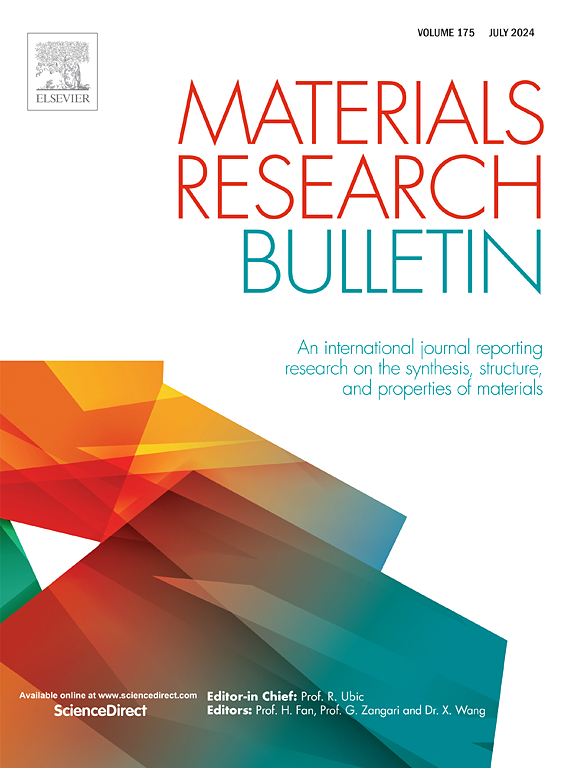Plasmonic Au-nanoparticles functionalized ultra-flexible Ga₂O₃ photodetector for enhanced broadband detection from UV-C to NIR on a paper substrate
IF 5.3
3区 材料科学
Q2 MATERIALS SCIENCE, MULTIDISCIPLINARY
引用次数: 0
Abstract
With the rising demands of wearable electronics, Internet of Things (IoT) sensors, environmental monitoring, and biomedical diagnostics, there is an increased demand for ultra-flexible, self-powered broadband photodetectors with high sensitivity and fast response. Conventional photodetectors generally suffer from insufficient spectral response and low responsivity, which limits their efficiency in practical applications. To overcome these limitations, we have developed ultra-flexible Ga₂O₃-based photodetectors with plasmonic Au-nanoparticles (Au-NPs) on a paper substrate. Incorporating Au-NPs enhances light absorption through localized surface plasmon resonance, extending the detection range from UV-C to NIR. The pristine device exhibits a responsivity of 20.96 mA/W at 266 nm, while the Au-NP-functionalized device achieves 38.86 mA/W, demonstrating a ∼185 % enhancement due to efficient hot carrier generation and improved charge transfer. The device also shows maximum detectivity values of 1.92×1010 Jones at 266 nm, 3.69×109 Jones at 532 nm, and 1.74×109 Jones at 1064 nm, respectively. Furthermore, the device reaches maximum responsivities of 7357 mA/W (266 nm), 163 mA/W (532 nm), and 6.31 mA/W (1064 nm) under a 5 V applied bias. This technique provides a pathway for developing nanoplasmonic-enhanced, flexible, self-powered photodetectors that provide high performance toward next-generation wearable optoelectronic devices.

等离子体au纳米粒子功能化的超柔性Ga₂O₃光电探测器,用于增强从UV-C到近红外在纸基上的宽带检测
随着可穿戴电子产品、物联网(IoT)传感器、环境监测和生物医学诊断的需求不断增长,对超灵活、高灵敏度、快速响应的自供电宽带光电探测器的需求不断增加。传统光电探测器普遍存在光谱响应不足、响应率低等问题,限制了其实际应用效率。为了克服这些限制,我们开发了基于Ga₂O₃的超柔性光电探测器,其等离子体au纳米粒子(Au-NPs)位于纸衬底上。结合Au-NPs通过局部表面等离子体共振增强光吸收,将检测范围从UV-C扩展到近红外。原始器件在266 nm处的响应率为20.96 mA/W,而au - np功能化器件的响应率为38.86 mA/W,由于高效的热载流子生成和改进的电荷转移,其响应率提高了~ 185%。该器件还显示出1.92×1010 Jones在266 nm, 3.69×109 Jones在532 nm和1.74×109 Jones在1064 nm的最大探测值。此外,该器件在5v偏压下的最大响应度分别为7357 mA/W (266 nm)、163 mA/W (532 nm)和6.31 mA/W (1064 nm)。该技术为开发纳米等离子体增强、柔性、自供电的光电探测器提供了一条途径,为下一代可穿戴光电器件提供高性能。
本文章由计算机程序翻译,如有差异,请以英文原文为准。
求助全文
约1分钟内获得全文
求助全文
来源期刊

Materials Research Bulletin
工程技术-材料科学:综合
CiteScore
9.80
自引率
5.60%
发文量
372
审稿时长
42 days
期刊介绍:
Materials Research Bulletin is an international journal reporting high-impact research on processing-structure-property relationships in functional materials and nanomaterials with interesting electronic, magnetic, optical, thermal, mechanical or catalytic properties. Papers purely on thermodynamics or theoretical calculations (e.g., density functional theory) do not fall within the scope of the journal unless they also demonstrate a clear link to physical properties. Topics covered include functional materials (e.g., dielectrics, pyroelectrics, piezoelectrics, ferroelectrics, relaxors, thermoelectrics, etc.); electrochemistry and solid-state ionics (e.g., photovoltaics, batteries, sensors, and fuel cells); nanomaterials, graphene, and nanocomposites; luminescence and photocatalysis; crystal-structure and defect-structure analysis; novel electronics; non-crystalline solids; flexible electronics; protein-material interactions; and polymeric ion-exchange membranes.
 求助内容:
求助内容: 应助结果提醒方式:
应助结果提醒方式:


